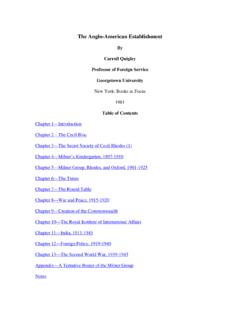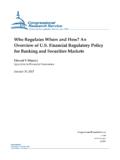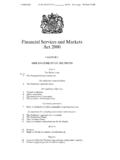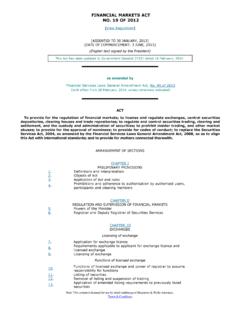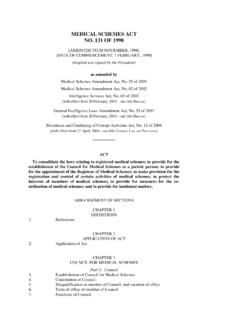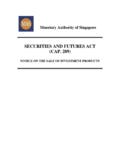Transcription of The Financial Crisis in the US: Key Events, Causes and ...
1 RESEARCH PAPER 09/34 22 APRIL 2009 The Financial Crisis in the US: key events, Causes and responses The current Financial Crisis started in the US housing market in 2007. The Crisis spread across the world and severely damaged the economies of many countries, including the US, and reached a new level in September 2008 as a number of prominent US-based Financial institutions, including AIG and Lehman Brothers, collapsed. This Research Paper first examines the underlying Causes of the Crisis in the US. In particular, it examines the emergence and collapse of the housing bubble and the significance of the complex Financial instruments that transformed an asset price correction into a significant domestic and global economic downturn. The main focus is the response of governing institutions in the US. Looking at responses before and after September 2008 drawing comparison with the UK where relevant this Paper examines the actions of a wide range of institutions including the Federal Reserve, US Treasury, Congress, Securities and Exchange Commission and Federal Deposit Insurance Corporation.
2 John Marshall BUSINESS AND TRANSPORT SECTION HOUSE OF COMMONS LIBRARY RESEARCH PAPER 09/34 2 Recent Library Research Papers include: 09/19 Small Business Rate Relief (Automatic Payment) Bill [Bill 13 of 2008-09] 09/20 Economic Indicators, March 2009 09/21 Statutory Redundancy Pay (Amendment) Bill [Bill 12 of 2008-09] 09/22 Industry and Exports ( Financial Support) Bill [Bill 70 of 2008-09] 09/23 Welfare Reform Bill: Committee Stage Report 09/24 Royal Marriages and Succession to the Crown (Prevention of Discrimination) Bill [Bill 29 of 2008-09] 09/25 Fuel Poverty Bill [Bill 11 of 2008-09] 09/26 Unemployment by Constituency, February 2009 09/27 Coroners and Justice Bill: Committee Stage Report 09/28 Geneva Conventions and United Nations Personnel (Protocols) Bill [HL] [Bill 69 of 2008-09] 09/29 Members pay and the independent review process 09/30 Economic Indicators, April 2009 09/31 Members since 1979 09/32 Unemployment by Constituency, March 2009 09/33 Apprenticeships, Skills, Children and Learning Bill: Committee Stage Report Research Papers are available as PDF files: to members of the general public on the Parliamentary web site, URL: within Parliament to users of the Parliamentary Intranet, URL.
3 Library Research Papers are compiled for the benefit of Members of Parliament and their personal staff. Authors are available to discuss the contents of these papers with Members and their staff but cannot advise members of the general public. We welcome comments on our papers; these should be sent to the Research Publications Officer, Room 407, 1 Derby Gate, London, SW1A 2DG or e-mailed to ISSN 1368-8456 RESEARCH PAPER 09/34 Summary of main points In September and October 2008, the US suffered a severe Financial dislocation that saw a number of large Financial institutions collapse. Although this shock was of particular note, it is best understood as the culmination of a credit crunch that had begun in the summer of 2006 and continued into 2007. The US housing market is seen by many as the root cause of the Financial Crisis . Since the late 1990s, house prices grew rapidly in response to a number of contributing factors including persistently low interest rates, over-generous lending and speculation.
4 The bursting of the housing bubble, in addition to simultaneous crashes in other asset bubbles, triggered the credit Crisis . However, it was the complex web of Financial innovations that had purportedly been employed to reduce risk which ensured that the Crisis spread across the Financial markets and into the real economy. In particular, all manner of profit-seeking Financial institutions used a complex Financial process characterised by highly leveraged borrowing, inadequate risk analysis and limited regulation to bet on one outcome a bet which proved to be misguided when asset prices collapsed. Prior to September 2008, the response from governing institutions in the US primarily sought to address liquidity concerns, stimulate demand and prevent mortgage foreclosures. The main policy responses included: the Federal Reserve (Fed) lowering interest rates as well as a introducing number of liquidity-enhancing schemes to abate the emerging credit Crisis ; the orderly takeover of failed investment bank Bear Stearns; and legislation seeking to stimulate demand and mitigate mortgage foreclosure.
5 After the shocks of September and October 2008, where credit and risk interest rate spreads shot up and the systemic nature of the Crisis became apparent, a new approach was adopted. In addition to the Fed, the US Treasury became a key body in administering the Emergency Economic Stabilization Act passed by Congress in October 2008. The central features of the post-September response included: the Fed and US Treasury decision not to bail out investment bank Lehman Brothers; Treasury-administered capital injections into troubled Financial institutions in exchange for preferred stock and common equity stakes; a sequence of bailouts by the Fed and Treasury for the insurance giant AIG; continuing efforts from the Fed to lower interest rates and increase liquidity; the unprecedented purchase of mortgage-backed securities and Treasury bills as part of the Fed s policy of credit easing ; the temporary suspension of the short-selling of Financial institutions by the Securities and Exchange Commission; the Homeowner Affordability and Stability Plan, which permitted struggling homeowners to refinance their mortgages.
6 And the passage of the $787bn American Recovery and Reinvestment Act designed to reinvigorate demand in the US economy. This paper contains appendices providing a glossary of key concepts and a list of acronyms. 3 RESEARCH PAPER 09/34 4 RESEARCH PAPER 09/34 CONTENTS I Introduction 7 II Causes of the Financial turmoil 10 A. The US housing market 10 1. Creation of a housing bubble 10 2. The collapse of the bubble 13 B. The role of the Financial industry 15 1. The web of Financial instruments 15 2. The housing crash and the finance industry 20 III Policy responses 26 A. Responses before September 2008 26 1. The Federal Reserve 26 2. Legislation 28 3. US Treasury 29 4. Other regulatory agencies 29 5.
7 Summary 29 B. Responses after September 2008 30 1. Troubled Asset Recovery Program and the Economic Stabilization Act of 2008 30 2. The Federal Reserve 38 3. US Treasury 41 4. Other regulatory agencies 43 5. Responses to AIG 45 6. The housing market 48 7. Fiscal stimulus 49 8. Summary 49 Appendix 1 Glossary of terms 50 Appendix 2 List of acronyms 54 5 RESEARCH PAPER 09/34 6 RESEARCH PAPER 09/34 I Introduction The Financial turmoil that engulfed the US during 2007-09 began in the mortgage lending markets. Indicators of the emerging problems came in early 2007 when, first, the Federal Home Loan Mortgage Corporation (commonly known as Freddie Mac or Freddie) announced it would no longer purchase high-risk mortgages and, second, New Century Financial Corporation a leading mortgage lender to riskier customers filed for bankruptcy.
8 The Crisis set in as house prices started to fall and the number of foreclosures rose dramatically. This in turn caused credit rating agencies to downgrade their risk assessments of asset-backed Financial instruments1 in mid-2007. The increased risk restricted the ability of the issuers of these Financial products to pay interest, and reflected the realisation that the bursting of the US housing and credit bubbles would entail unforeseen losses for asset-backed Financial instruments. Between the third quarter of 2007 and the second quarter of 2008, $ of mortgage-backed securities received downgrades to reflect the reassessment of their This represented an immediate and severe dislocation of the Financial markets: The odds are only about 1 in 10,000 that a bond will go from the highest grade, AAA, to the low-quality CCC level during a calendar year.
9 So imagine investors' surprise on Aug. 21 when, in a single day, S&P slashed its ratings on two sets of AAA bonds backed by residential mortgage securities to CCC+ and CCC, instantly changing their status from top quality to pure Amidst continuing tight credit markets,5 mortgage and Financial firms received support from the Federal Reserve (Fed) through short-term lending facilities and auctions for the sale of mortgage-related Financial products. However, such actions were unable to prevent rapid falls in asset prices as institutions sought to relieve themselves of these risky burdens and replenish their risk-weighted6 capital ratios. Mortgage lender Countrywide Financial was bought by Bank of America for $4bn in January 2008, while many other firms had their credit ratings downgraded. Bear Stearns, a large American investment bank which had engaged heavily in mortgage-backed securities, was severely damaged.
10 Unable to recapitalise sufficiently to cover its losses, it could not survive when its stock price collapsed in March 2008 and it was ultimately acquired by Morgan Chase on 16 March 2008 in a government-assisted takeover. 1 A Financial instrument which uses some form of asset as collateral. This included commercial paper the short-term debt issued by firms. 2 Both billions and trillion are given in the widely used US terms. Please see Appendix 1 for further details. 3 The woman who called Wall Street s meltdown, Fortune, 4 August 2008 4 Anatomy Of A Ratings Downgrade, BusinessWeek, 1 October 2007 5 John B. Taylor, The Financial Crisis and the Policy Responses: An Empirical Analysis of What Went Wrong, November 2008, p9 6 Please see Appendix 1 for further details. 7 RESEARCH PAPER 09/34 With mortgage delinquency and default rates continuing to rise, mortgage lenders also faced problems as the value of their collateral (or the assets used to secure the loans) fell.


